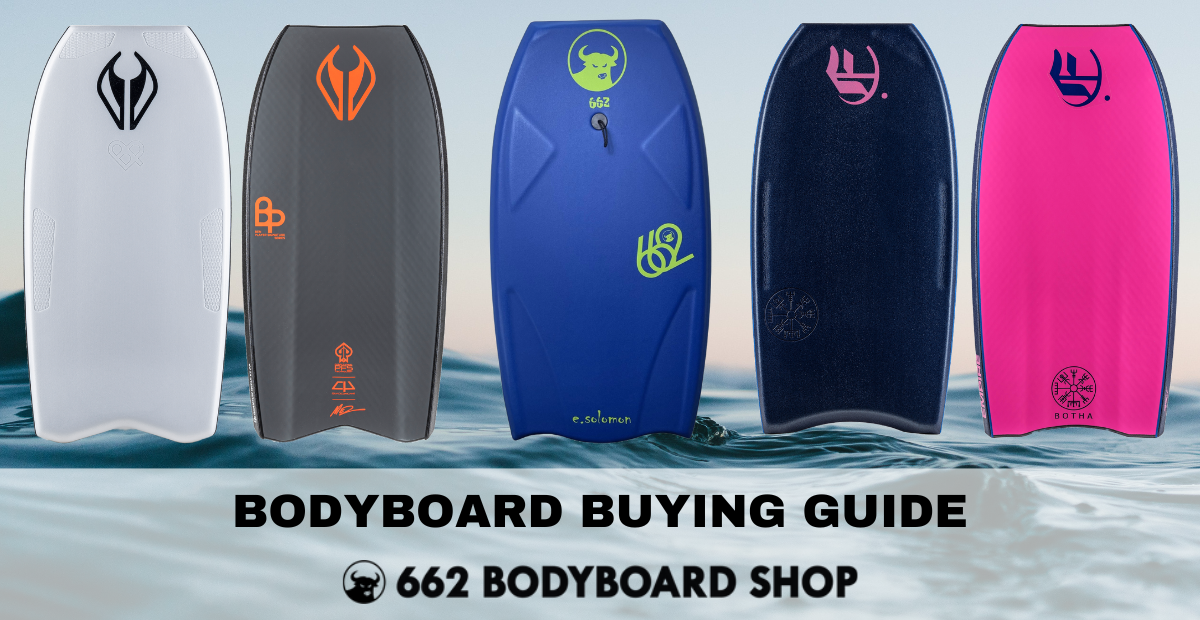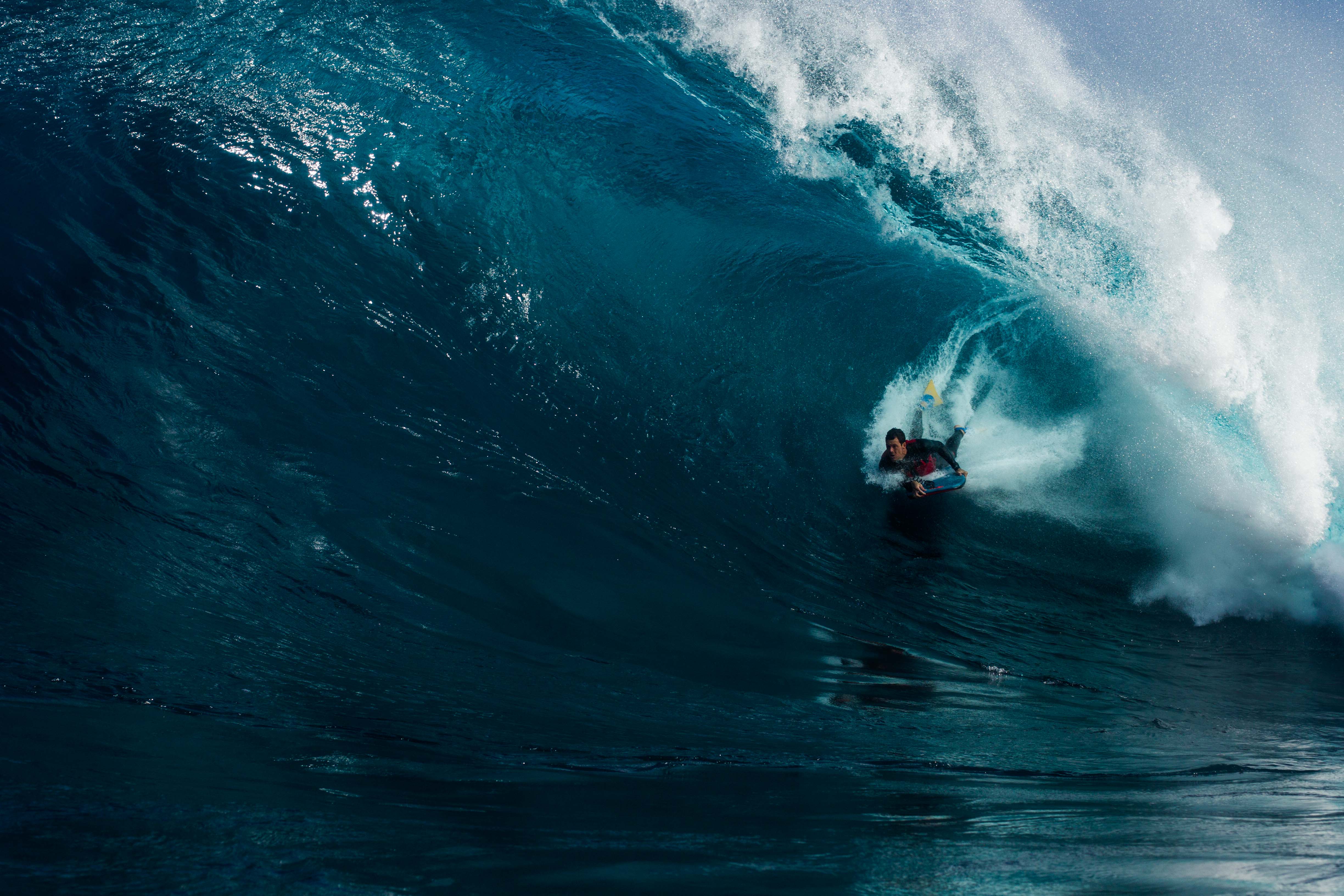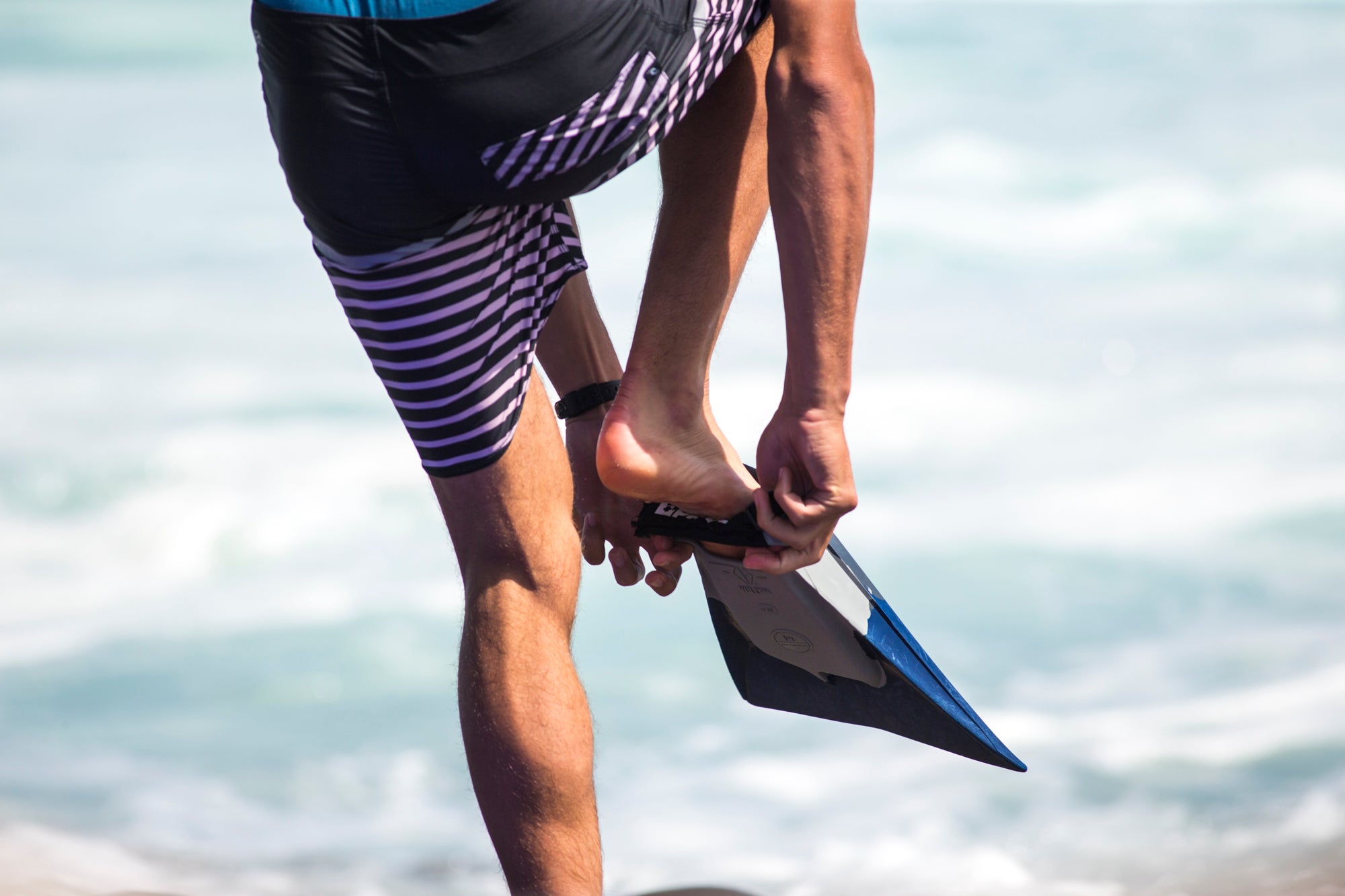Swim Fin Buying Guide: How to Choose, Fitting, & More
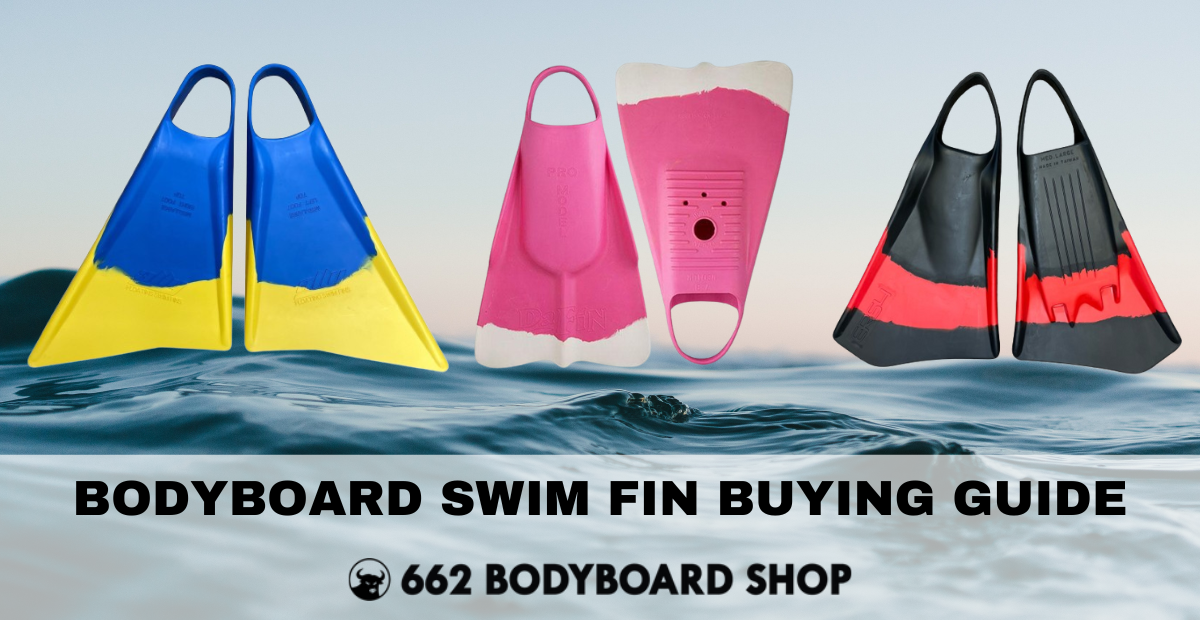
Swim fins are an essential piece of gear for any bodyboarder looking to swim efficiently and catch more waves. Choosing the right pair of fins to meet your physical needs and riding style is key to getting the most out of your bodyboarding sessions. Although selecting a pair may seem straight forward, finding the best swim fins for your needs can be tricky considering the wide variety of fin styles, shapes, sizes, and performance features available. We’ve got you covered with everything you need to know about bodyboard and body surfing swim fins!
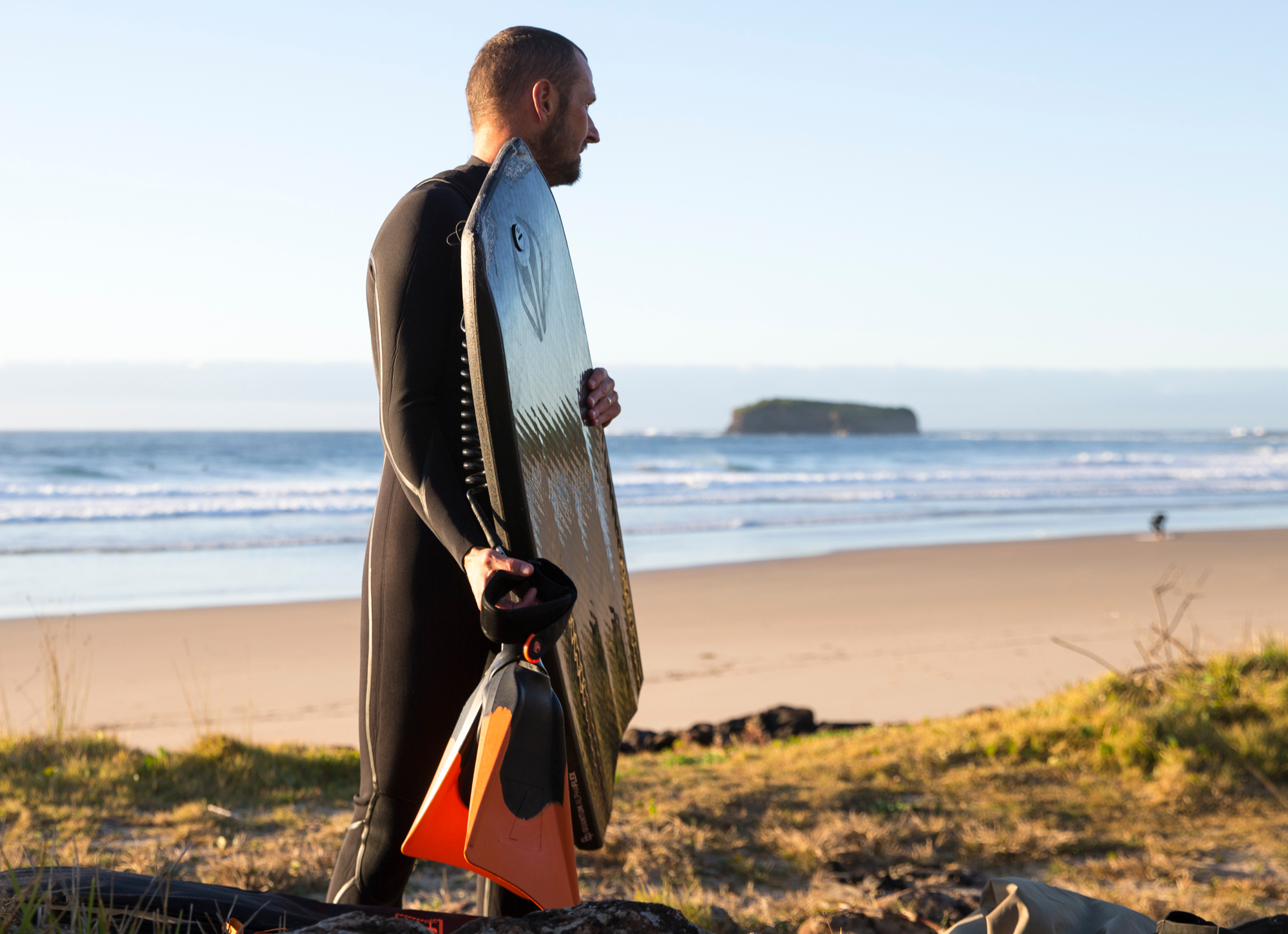
Our Experience with Bodyboard Swim Fins
Our Staff at 662 Bodyboard shop has enjoyed helping bodyboarders find their perfect pair of swim fins for over 20 years. Our brand was launched in 2003 out of a small garage by Eddie Solomon, a Southern California bodyboarder known for his aggressive, big wave riding at legendary spots like Waimea Shorebreak and The Wedge. For close to ten years, he operated several bodyboard only stores and created one of the first and most successful online bodyboard shops in existence.
During this time, Eddie also launched his own swim fin companies, Ally Swim Fins, and ERS4 Swim Fins, with a focus on comfort, power, and performance. Sadly, we lost Eddie far too early but the positive impact he left on the sport will never be forgotten. To this day, 662 Bodyboard Shop is 100% family owned and operated in Costa Mesa, CA. We are committed to helping you find the highest quality products from the best brands the bodyboarding industry has to offer. Utilizing these years of experience, we’ve put together this swim fin guide to help you choose a new pair, get the right fit, and care for your fins to extend their longevity.Table of Contents
Benefits of Bodyboard Swim Fins
Young kids or complete beginners will be in our shop and ask, “Do you need fins for bodyboarding?” - For young kids staying in shallow water or catching crashed waves/white water, no, they are not a necessity. For any bodyboarder over the age of 7-8 or so (Depending on swimming ability and confidence in the ocean), or for anyone looking to catch waves where they are not able to touch the seafloor, then yes, swim fins are a must for a variety of reasons.
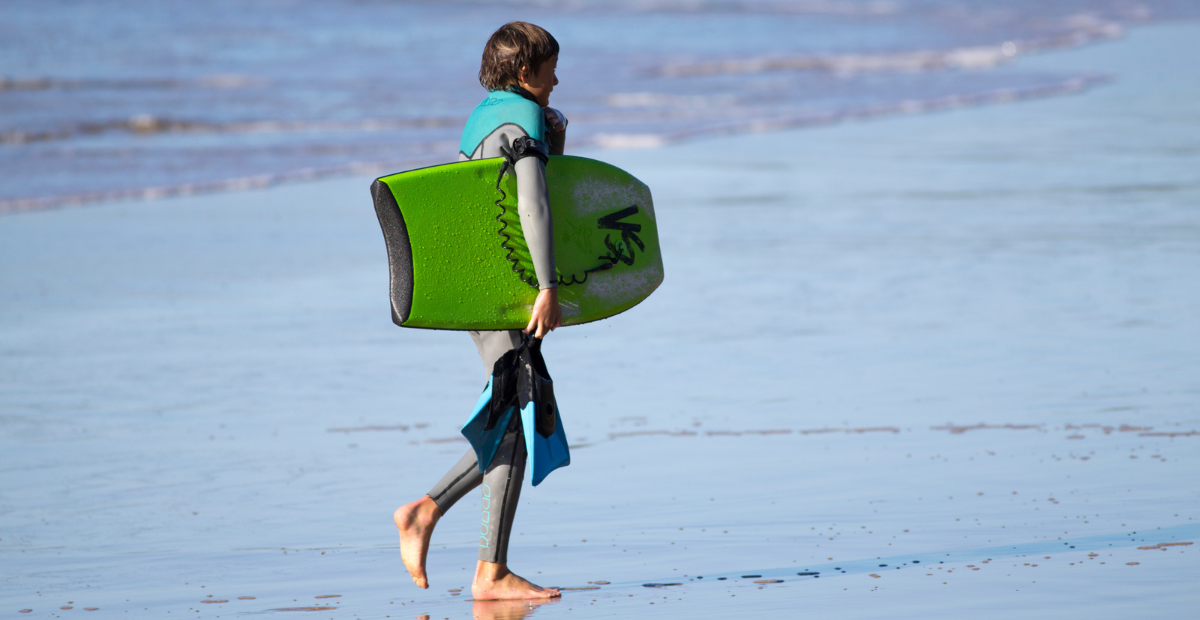
The main benefit of swim fins is known by anyone who has ever tried them - When kicking with fins they help you propel through the water and swim faster than you would without fins! Thanks to the enhanced swim efficiency that fins provide, they also offer the following benefits:
- Swim fins give you greater control while bodyboarding as they allow you utilize the rail of the fin to hold onto waves and better execute turns, spins, or other maneuvers
- Swim fins also help you stay safe in case you need to quickly swim to shore, avoid someone riding a wave towards you, help someone in the water, or if you are thrown underwater and need to swim to the surface for air
- Most importantly, you’ll be able to swim past wave breaks easier, duck dive beneath waves more efficiently, and cover more ground in the lineup to be able to catch more waves
As you can see, swim fins are a necessity for a more safe and enjoyable bodyboard experience!
Swim Fin History & Anatomy
Swim fin designs have changed greatly over the years since being invented in 1717. Most people remember Benjamin Franklin for being a Founding Father of the United States, but we can think of him as the Founding Father of Swim Fins! Ben Franklin loved swimming, but wanted to swim faster, so he invented the first swim fins when he was only 11 years old. His original invention was simply wooden hand planks and boards strapped to his ankles. Needless to say, there was a lot of room for improvement with the design of swim fins.
Fast forward to today and there are a variety of swim fins, also known as flippers designed for all types of water sports. For example, in deep water diving you’ll often see very long, very bendy fins used. All swim fins are designed for different uses and for our purposes, we are focused on the main types of fins from trusted bodyboard brands. While we primarily focus on swim fins for bodyboarding, the fins that we cover in this guide could also be used for body surfing, pool training, or any type of swimming that you prefer.
Before we get into the differences between swim fins, let’s do a quick review of the different parts and features of swim fins:

- Swim Fin Blade - This is the part of the fin that extends past your toes. Without the blade, a swim fin is essentially just a rubber shoe. The blade is the essential part of a swim fin and is the key focus for deciding between fins. Blades can come in different styles, shapes, and stiffness, which directly affect performance in the water.
- Swim Fin Rail or Side Bars - This is the inner and outer edges of a swim fin. These edges are called rails, or side bars. The rails are made from stiff rubber to help retain fin shape, but offer some give or bend, so that they can move or push water during a kick more easily. The length and stiffness of rails greatly determines the overall feel and performance for swim fins.
- Foot Pocket - This is the pocket or opening within the fin where you insert your foot. Most swim fins and foot pockets are made from soft rubber to provide your feet a comfortable and secure place to be within the fin. A lot of bodyboarders will wear swim fin socks or pads to help their feet be more comfortable, fit more snuggly, and avoid skin irritation within the foot pocket.
- Ankle Straps - This is the rounded strap that connects to the foot pocket. You place your feet within the foot pocket, and the ankle straps will secure your swim fins on your feet. Without ankle straps, your fins would almost surely fall off when kicking in water. Even with ankle straps, swim fins can still fall off your feet, making swim fin tethers very popular amongst bodyboarders and bodysurfers.
- Drainage Hole - There are not drainage holes on every type of swim fin, but you will almost always find these on bodyboard swim fins. Drainage holes allow water, sand, rocks, broken shells, or debris to flow through the fin rather than get stuck in the fin. For water in particular, this is very important for reducing the weight and drag of fins, since not having a drainage hole would mean that your fins could collect water, making them heavier, and harder to kick with or lift out of the water. Allowing sand and rocks to escape fins is also important for foot comfort, just like having a rock in your shoe, having a rock in your swim fin is no fun either!
Swim Fin Styles, Shapes, & Stiffness
Fins come in two different blade styles or shapes: symmetrical and asymmetrical. As you can see in the image below, the symmetrical fins are balanced in shape, whereas the asymmetrical fins are unbalanced. While these shapes may not seem too different at first glance, there are key performance differences to be aware of.
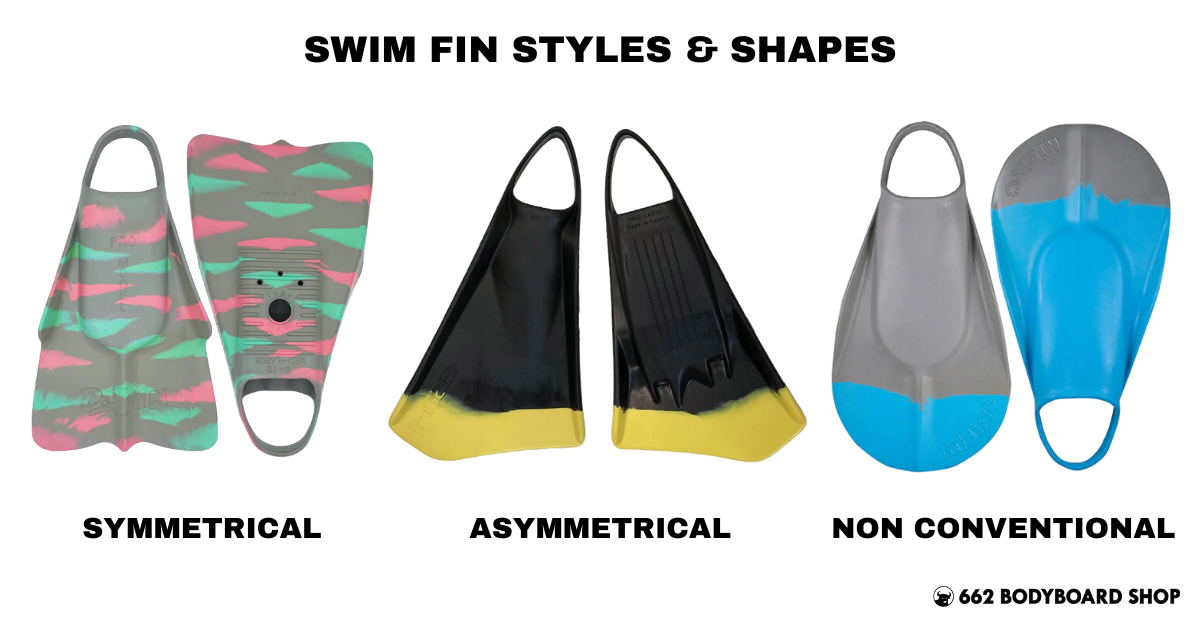
Symmetrical Fins (Balanced Shape)
- Symmetrical fins typically have a universal fit, meaning you can wear each fin on either foot (No left or right foot specific fin) and are generally a wide triangle type shape
- Symmetrical fins typically have less surface area than asymmetrical fins, making it easier to kick for beginners which also helps to reduce strain or cramping in the legs
- Some riders feel that the symmetrical shape can provide more balanced thrust
- Shorter, symmetrical fins are typically the go to for drop knee bodyboarding, but this is the only riding style that has a defined ideal fin type
Asymmetrical Fins (Unbalanced or Dolphin Shape)
- Inspired by the shape of a dolphin's powerful tail, asymmetrical fins feature rigid (Stiffer) outer blade sections to accommodate for their extended length and larger surface area
- They will typically have a strengthened rail on the longer side of the fin or both sides to allow for greater propulsion through the water
- The longer outer edge aligns with the leg to help you hold on the wave, which can help provide greater control
Non Conventional Fin Styles & Shapes
- Some swim fin manufacturers offer swim fin styles that are more unique, and are not the typical wide triangle or dolphin tail shape
- One of the more common fin styles that you will see is an oval or rounded shape, which are used by brands such as Kicks from DaFin
- Since these oval swim fins are symmetrical, they generally offer the benefits outlined above for symmetrical fins
- When shopping for swim fins, you may also see other new shapes, but in general, the three shapes covered here are the tried and true options that will lead you to success in the water
Fin Stiffness Levels (How much bend or give do fins have)
One level of fin stiffness is not necessarily better than the other. Fin stiffness selection comes down to your physical needs and personal preference.
Here are the key differences between stiff and less stiff swim fin blades:
Stiff Fin Blades
- Pros: Can provide more response, power, thrust, and quicker acceleration
- Cons: Are typically less comfortable than softer or more bendy blades, which can lead to more muscle strain, or cramps for riders who need to build endurance or who swim for long periods of time
- Recommendation: Typically better suited for intermediate to advanced bodyboarders who are willing to sacrifice a little bit of comfort for faster acceleration
Less Stiff Fin Blades
- Pros: You can kick faster and they are typically more comfortable as they put less strain on your muscles and joints due to their give in the water
- Cons: Can require more effort or extra kicking to accelerate as quickly as stiff fins
- Recommendation: Can be a better option for beginners looking to grow their endurance, are ideal for people with leg or knee issues, or they can be great for any level bodyboarder or bodysurfer looking for longer sessions in the water
Overall, most symmetrical fins will typically feel a little less stiff than asymmetrical fins. Although there are some general recommendations for each type, there is no right or wrong selection when it comes to fin style, shape, or stiffness - it’s all personal preference!
You may find that after testing fins, one type or another may feel better on your joints or ankles. Don’t be discouraged if your swim fins don’t feel right when using them at first, or if you find yourself struggling to kick with them comfortably for a long period of time. There’s a break in period for fins which we’ll cover later in this guide, and ramping up your leg, ankle, and foot endurance can be a long process.
How Should Bodyboard Fins Fit?
Finding your proper fin size or fit is crucial for comfort and performance. Before you think about selecting a pair of fins, make sure that you know what size fin you need.
For example, you may want a certain style of fins, but if a brand doesn’t offer your size, then don’t force it. Last thing you want is an improper fitting pair of fins that fall off your feet because they’re too large or a pair that’s too small and causes painful blisters or foot cramping!

Once you get your pair of fins, be sure to try them on and make sure that they fit snugly but not too tight. Poor fitting fins can lead to foot pain, ankle pain, blisters, or cramping, especially when new. Some bodyboarders like to wet the fins before sliding them on but this is a personal preference. Swim fin socks or pads can help you get a snug fit if you fall between sizes and will help prevent the fins from rubbing on your skin as you kick. Fin socks can add a half size or 1-2 shoe sizes depending on which kind you choose, so keep this in mind when selecting fins.
Remember, the way fins fit when dry may be different than in the water. Feet can shrink in colder water or swell in warmer water but don’t worry about this too much. An ideal snug fit will minimize excess foot movement in your fins while preventing cramps or irritation. At the end of the day, a lot of beginner bodyboarders don’t love the feel of swim fins. Naturally, we like our feet to feel free but overtime, you will get used to having them on and won't even notice them while chasing waves!
Bodyboard Swim Fin Size Charts
Most fins are made to follow a typical letter sizing system such as small, medium, large, and extra large. You may also see a longer list of sizes such as XS (extra small), S, M, ML (Medium large), L, XL, & XXL (Double extra large)- These sizes correspond to specific shoe sizes. If you don’t know your shoe size, measure your foot to determine your size. Different swim fin brands may have different sizing, so be sure to reference their sizing charts when available.
By comparing different brand size charts, you can get a general estimate of fin sizing and how it aligns with various shoe sizes, but in general, it’s always best to follow specific brand ranges.
For a rough idea of what swim fin sizing could look like between a handful of brands, here are some general sizing ranges:
| Swim Fin Size Range | U.S. Men Shoe Size | U.S. Women Shoe Size |
| Extra Small (XS) | 2 - 4 | 3 - 5.5 |
| Small (S) | 5 - 6.5 | 6 - 8 |
| Medium (MD) | 7 - 8.5 | 8.5 - 10.5 |
| Medium Large (ML) | 9 - 10 | 10.5 - 11.5 |
| Large (L) | 11 - 12.5 | 12 - 14 |
| Extra Large (XL) | 13 - 14 | 14.5 - 15.5 |
More importantly, be sure to check the sizing for specific swim fin brands that you are interested in. Here are the sizing charts for some of the most popular bodyboard swim fin brands:
For Ally Swim Fins and ERS4 Swim Fins, sizing is as follows:
For DaFin Swim Fins, sizing is as follows:
| Swim Fin Size | U.S. Men Shoe Size | U.S. Women Shoe Size |
| Extra Extra Small (XXS) | 1 - 2 | 2 - 3.5 |
| Extra Small (XS) | 3 - 4 | 4 - 5.5 |
| Small (S) | 5 - 6 | 6 - 7.5 |
| Medium (MD) | 7 - 8 | 8 - 9.5 |
| Medium Large (ML) | 9 - 10 | 10 - 11.5 |
| Large (L) | 11 - 12 | 12 - 13.5 |
| Extra Large (XL) | 13 - 14 | 14 - 15.5 |
For DMC Swim Fins, sizing is as follows:
| Swim Fin Size | U.S. Men Shoe Size | U.S. Women Shoe Size |
| Extra Extra Small (XXS) | 3 - 4 | 4 -5 |
| Extra Small (XS) | 4 - 5 | 6 - 7 |
| Small (S) | 6 - 7 | 8 - 9 |
| Medium (MD) | 8 - 9 | 9 - 10 |
| Medium Large (ML) | 9 - 10 | 10 - 11 |
| Large (L) | 10 - 12 | 12 - 13 |
| Extra Large (XL) | 12 - 13 | 13+ |
For Mike Stewart Viper Swim Fins, sizing is as follows:
| Swim Fin Size | U.S. Men Shoe Size | U.S. Women Shoe Size |
| Extra Small (XS) | 3 -4 | 4.5 - 5 |
| Small (S) | 4 - 6 | 6 - 7.5 |
| Medium (MD) | 7 - 8 | 7 - 8 |
| Medium Large (ML) | 8 - 10 | 10 - 11.5 |
| Large (L) | 10 -11 | 11 - 12.5 |
| Extra Large (XL) | 11 -13 | 13 - 14.5 |
| Extra Extra Large (XXL) | 14 - 15 | 15 - 16 |
For Vulcan Swim Fins, sizing is as follows:
| Swim Fin Size | U.S. Men Shoe Size | U.S. Women Shoe Size |
| Small (S) | 6 - 7 | 7.5 - 8.5 |
| Medium (MD) | 7.5 - 9 | 9 - 10.5 |
| Medium Large (ML) | 9.5 - 10 | 11 - 11.5 |
| Large (L) | 10 - 11.5 | 11.5 - 13 |
Tips for Choosing Fins
- New bodyboarders - Focus on comfort and ease of use. Softer, less stiff fins anywhere between $60 - $100 will last you years if properly taken care of.
- Intermediate/Advanced bodyboarders - Depends on rider preference. A lot of advanced bodyboarders prefer stiffer fins since they provide more thrust. More thrust means more efficient swimming but more strain on your legs.
- Youth Swim Fins / Jr. Lifeguard Fins - For most Jr. Lifeguards and kids in general, we recommend shorter, symmetrical shape fins, thanks to their beginner friendliness, ease to put on, comfort, and propulsion that they provide in the water. Visit our Jr. Lifeguard swim fin collection for more details on fin options.
- Drop knee riding - Shorter, stiffer blades perform best for getting your foot up on the board. Long fins should be avoided for drop knee riders.
- Bodysurfing, general swimming, and pool training - Depending on what water activity you are doing, there may be one fin type that could be more ideal over another, but really this comes down to personal preference. For bodysurfing and general swimming, any type of swim fin is at your disposal. For pool training, or for triathletes in particular, DMC Swim Fins are a great option as they offer fin designs specifically tailored for different water sport needs.
Swim Fin Accessories
Besides selecting the best swim fins for your needs, picking up some accessories for your swim fins can go a long way with enhancing your comfort in the water.
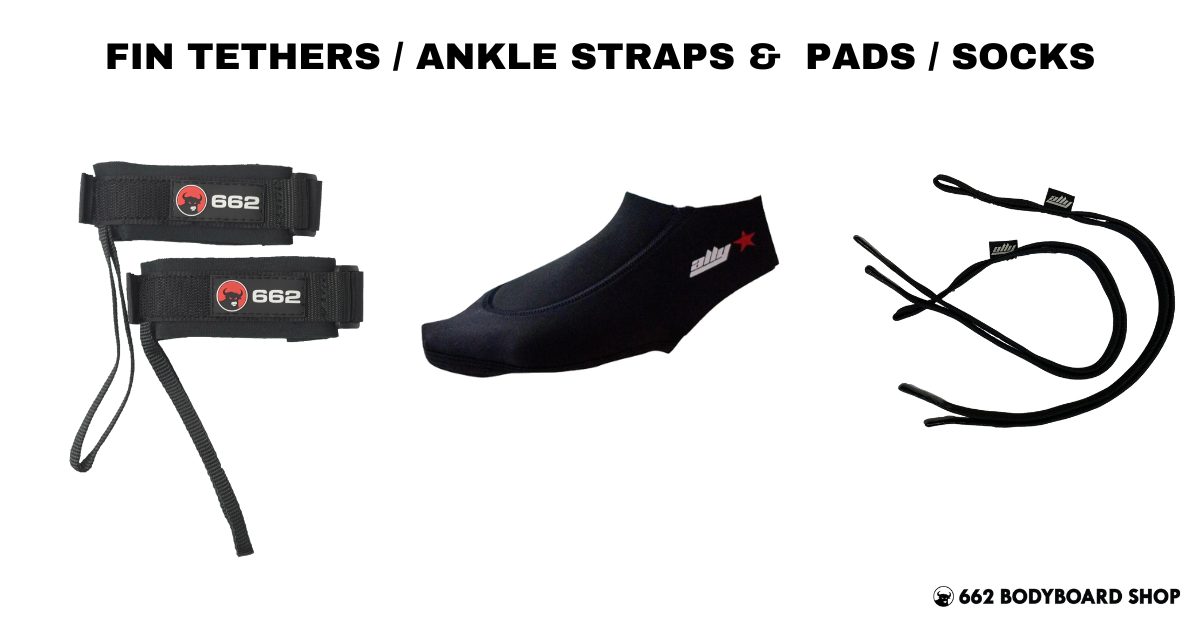
Swim Fin Tethers (Ankle Straps)
Even the most snug swim fins can fall off your feet if you are bodyboarding in rough conditions. Although most swim fins float these days, losing fins in waves can make it tricky to find them. Losing and having to replace perfectly good fins is no fun, so we highly recommend attaching swim fin tethers also known as ankle straps to your fins which velcro or tie around your ankles for added security.
Swim Fin Socks
For a more snug fit, extra warmth, and added comfort, picking up a pair of swim fin pads or socks is also ideal. Most swim fin socks are made from materials similar to what you would find in a wetsuit, making them great for foot warmth and blood circulation in cold water temperatures.
The biggest benefit of fin socks for bodyboarders in any water temperature is their ability to prevent excessive rubbing and blisters. By providing a layer of protection between your foot and fin rubber, fin socks help protect your skin! These are highly recommended for new bodyboarders or those who bodyboard for long periods of time as it takes some time to build up skin toughness on the back of your heel and in general, if you bodyboard long enough in a single session, you will eventually cause irritation on your skin.
Breaking In Fins & Preventing Discomfort
Swim fins will take some time to break in and become more comfortable. The first time you wear your fins in the water, they will be their tightest and stiffest. As you bodyboard with a new pair more, the fit should loosen up, they will become a little less stiff, and they should feel more comfortable on your feet. Don’t be discouraged if they don’t feel perfect on your first trip to the beach, the more you break them in, the more natural they will feel.

Sometimes a new pair of fins won’t bother you at all and you can be in the water for hours. Other times, you may need to limit your initial bodyboard sessions to not be overly extensive while you break in your fins and build up leg strength. Breaking in fins is a case by case situation based on the fins used and bodyboarder or body surfer.
Caring for Your Fins
Here are some tips for taking care of your fins, avoiding damage, and extending their life:
- Rinse fins with fresh water after each use to prevent salt/sand damage
- Store fins in a cool, dry place out of direct sunlight when not using them
- Repair any splits or cracks immediately with fin resin products
- Always use fin tethers to prevent losing fins in the water
That’s it! With proper care, a pair of swim fins could last many years. More often than not, bodyboarders like to have a couple of different types of fins to experiment with and have available depending on the wave conditions. Having multiple pairs will also mean that if something happens to one pair, you have a backup pair just in case.
Final Steps for Selecting Fins
With the right pair of bodyboard fins suited for your physical needs, experience level and riding style, you'll be catching more waves and enjoying your bodyboard experience in no time! For additional insight on the most common questions we get from customers, be sure to continue reading below. If you still can’t decide on which pair of fins to get or which size, don’t hesitate to contact us if you are in need of assistance!
Shop Swim Fins
Frequently Asked Questions
Q: Can you bodyboard or bodysurf without fins?
A: While possible, fins give you the thrust and speed needed to catch more waves and swim more efficiently. Fins aren't necessary for young children but are a must for most adult bodyboarders and bodysurfers.
Q: What size fin do I need?
A: Measure your foot and match your foot size or your typical shoe size with the corresponding fin size from the manufacturer. If you plan to wear fin pads or socks, getting a half size to 2 sizes larger can be good depending on the thickness of your pads or socks.
Q: Which fins are best for beginners?
A: As a beginner, focus on comfort over performance. Shorter, softer, mid-stiffness fins will put less strain on your legs. Symmetrical or universal fit fins are easy to slip on without having to identify which fin is for which foot. Fins around $60 - $100 provide good value and should last years when properly taken care of. If you're a beginner wanting to learn everything you can about selecting the best bodyboard equipment for your needs, be sure to also check out our bodyboard buying guide.
Q: How can I prevent losing my fins?
A: Many fins now float but fin tethers or ankle straps are a must if you want peace of mind in the water! Swim fin tethers attach your fins to your body so you don't lose them in waves, currents, or during wipeouts.
Q: How do I make fins last longer?
A: Rinse off fins after use with fresh water to prevent salt/sand damage, don't store them in direct sunlight, repair any cracks immediately with fin resin, and keep them in a dry, cool place.
Q: How do I walk in my swim fins?
A: If your fins are short enough, and depending on what surface you are on, you should be able to walk in them without too much difficulty. In general though, the go-to method for bodyboarders is to turn their back to the ocean and walk into the water backwards. This will enable you to easily slide your feet, avoid tripping over your fins, and walk until you are no longer able to touch the seafloor or you decide to jump on your board and begin swimming!

